Over the past few posts, I’ve broken down some of the biggest electricity costs associated with my saltwater aquarium. The lights and return pump (if you have one) probably consume the most electricity (and therefore create the biggest cost), followed by aquarium powerheads, as a distant third.
Some aquarists choose to alternate the flow from their pumps to simulate wave, surge or turbulent flow–but in my tank, I run my powerheads 24 hours a day, 7 days a week–and there are two of them.
In addition to providing life-sustaining oxygenation and flow through our aquariums, these in-tank pumps are also used to feed our reactors and protein skimmers with the water they need to do their jobs.
Aquarium Powerhead Costs:
I set out to accomplish two things with the research for this post:
- Determine how much I’m currently spending on the electricity for my powerheads
- Compare the costs across brands to figure out what brand I should switch to
To answer these questions, I had to figure out how much I pay for electricity. I put together a spreadsheet to help with this calculation. You can find it here. The costs on your electric bill can be a little bit confusing because they break it up into several different component costs.
Here in Pennsylvania, I currently pay $0.15 per kilowatt-hour. As I mentioned before, I run my pumps 24 hours a day for 365 days a year–so the calculation goes like this:
24 x 365 x $0.15 x # watts divided by 1000
How much electricity do powerheads consume? From exploring the manufacturer data across 27 popular models, they consume about 2.6 to 60 watts, depending on the model. The average power consumption was 11.2 watts. The tables constructed below are based on the manufacturer’s information from Dr. Fosters and Marine Depot.
The Aqueon 500 and 700 models win the prize as the lowest wattage aquarium powerheads–sipping an energy-efficient 2.6 and 2.8 watts. Two Vortech models, the MP 40 and MP 60 consume the most electricity– at 28 and 60 watts respectively.
The Aqueon 700 and Hydor Koralia Evolution 1400
models share the first-place prize as the most efficient models on the market (measured as flow rate generated per watt of electricity). They pump an energy-efficient 250 GPH for every 1 watt of electricity that they sip.
If I were to attempt to crown a ‘most energy-efficient brand’, in terms of GPH per watt, it would by Hydor Koralia, which has 5 powerhead models that produce more than 200 gallons per hour of flow for every watt of electricity they consume.
Please note, this comparison is based on manufacturer specifications—I did not measure their flow rates or electrical consumption directly.
So how much do aquarium powerheads cost to run?
Based on my assessment, aquarium powerheads cost anywhere from $3.42 to $78.84 to run each and every year. That Vortech pump sure can move a lot of water, but that is an energy-intensive exercise.
$3-$80 per year in annual electricity costs is a pretty big range, so make sure you either love that energy-guzzling pump or pick one that is a bit more efficient.
The average electricity cost per year from this list is $14.67. I found that one of the two powerheads I had my tank prior to this analysis, the Hagen Aquaclear 70 I have had FOR YEARS costs two times the average cost per year–and 5 times as much as the most efficient brands.
Nostalgia aside for this work-horse powerhead that has stuck with me through thick and thin, I think I’m going to switch it out as a result of this assessment.
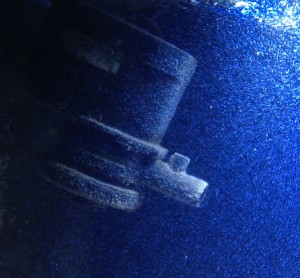
What about the newer gyre-style powerhead pumps?
A few years back, the first gyre-style powerhead pumps hit the market and made a big splash. They really will make a big splash if you have them set to 100% power and aren’t careful about setting them up. They move a whole lot of water, very efficiently.
The Maxspect Gyre XF250 moves 5,300 gallons of water per hour on 60 watts fo electricity. That caps out near the top of the range, at $70+ dollars a year in annual electricity costs, if you run it at full capacity. It also has a ~$300+ price tag.
The less expensive IceCap line of gyre pumps, like the IceCap 3k , can be purchased for around $150 and will generate 3,000 GPH flow while consuming 40 watts of electricity, which makes the annual running cost at about $53/year.
But the gyre design isn’t all about horsepower, it’s also about creating a circular flow in your tank that dispersed across a wider area than the traditional powerheads create.
Conclusions
Like many of the decisions in this reef aquarium hobby–the choice of which aquarium powerhead you want to use is going to be a mix of form, function, coolness factor and economy. There are very few black and white issues in this hobby. However, I think the notion of electricity consumption doesn’t really get a lot of airtime in this hobby.
It is clearly not the only parameter to compare. Each powerhead will come with its own unique way to attach to the tank wall. Some will hang over the side, others are mounted with suction cups, while still others use powerful magnets. I’ve personally had some issues with the suction cup variety becoming detached from the wall. This resulted in the destruction of a cool LPS coral, as the misdirected pump blasted away at the fleshy polyps one night, while I was sleeping.
Another point to consider is that not all water flow was created equally. The type of water flow created by the gyre pumps is often lauded as superior to that of the ‘point’ power the traditional and propeller water pumps provide.
Hopefully, this article provides you with a fair way to compare the annual running costs of each of the pumps, as a way to systematically and rationally compare across brands.
I also hope you’ll take the time to see if the pump in your tank is an energy guzzler–and consider replacing it if it is.
A question for you
How many powerheads do you run in your tank? How much are they contributing to the overall electricity costs of your aquarium? Leave a comment and let me know how these calculations stack up with your aquarium powerhead costs.
Disclosure
The pictures and some links on this page may contain affiliate links to those products on Amazon where you can read reviews of the products from real customers to balance out the purely mathematical analysis I have done here. If you purchase anything as a result of that visit, a small amount of money will be paid to me from Amazon at no additional cost to you.
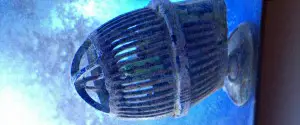
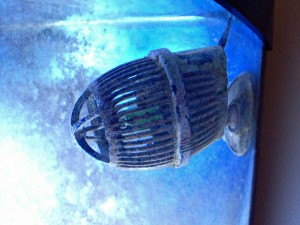
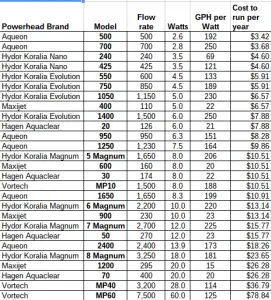
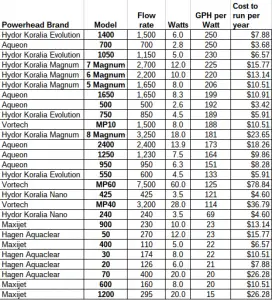

Leave a Reply